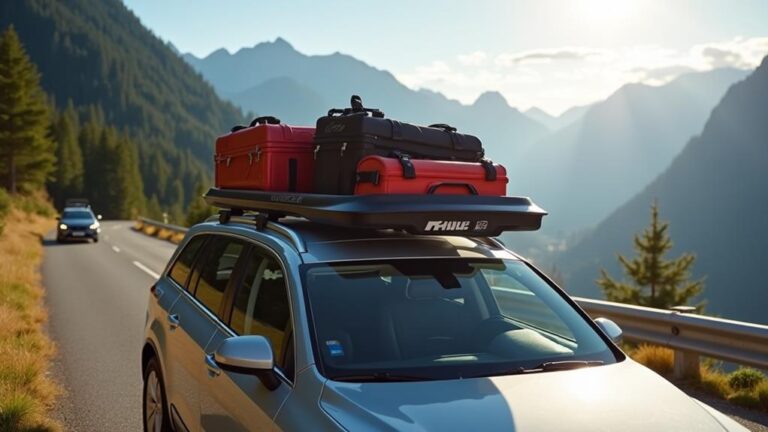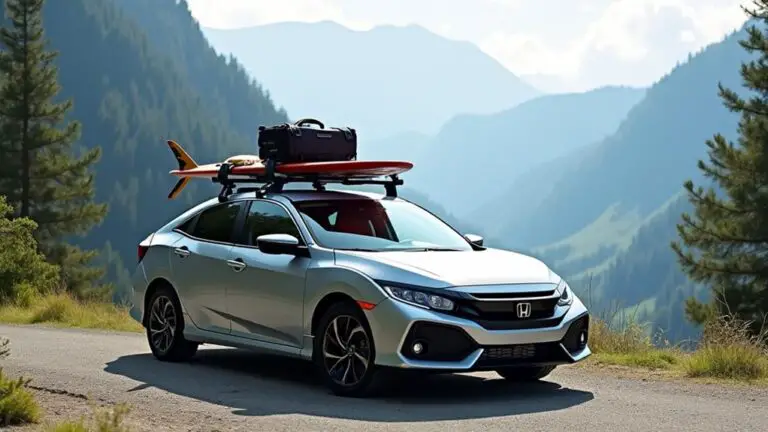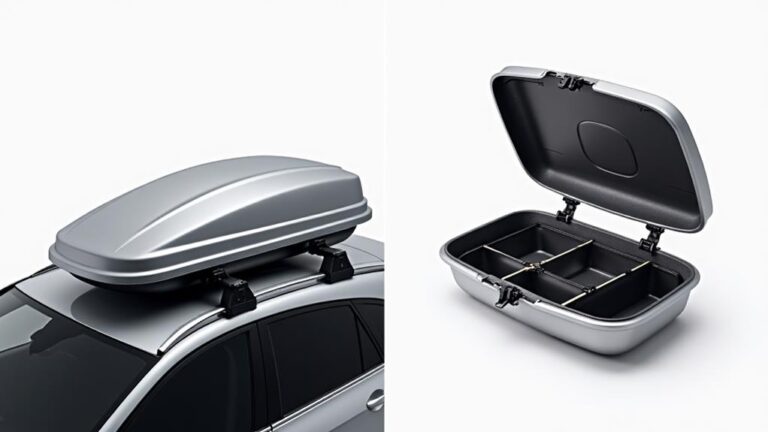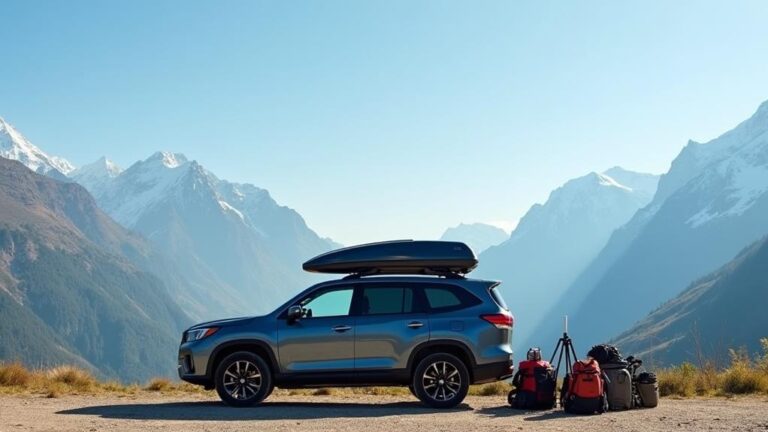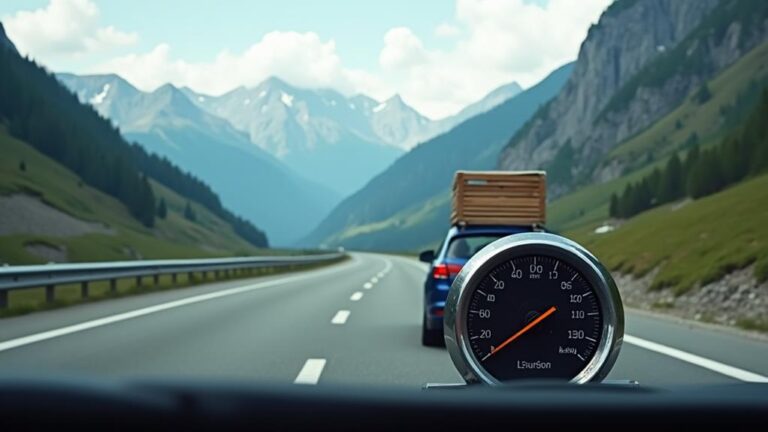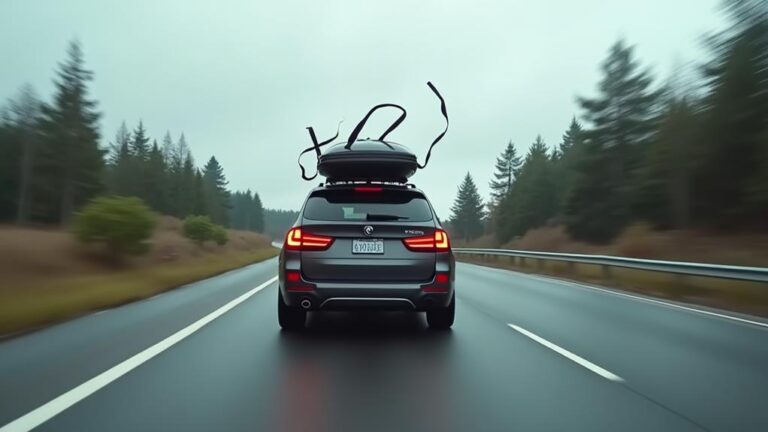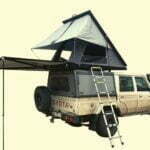You might be surprised to know that improper cargo box loading can increase your vehicle's risk of rollover by up to 30%. This statistic highlights the importance of careful planning when preparing for a road trip with a Thule cargo box. To guarantee a safe and enjoyable journey, it's vital to pack the right essentials and organize them efficiently. But what exactly are the must-haves for a stress-free road trip, and how can you maximize your cargo box's space? By exploring these questions, you'll be well on your way to a successful adventure.
Key Takeaways
- Categorize gear into essentials, such as luggage, tools, and emergency supplies for efficient packing.
- Distribute items evenly throughout the Thule cargo box for stable load balance and vehicle stability.
- Use dividers or organizers to separate gear and keep it organized for easy access and minimal wasted space.
- Pack a well-stocked emergency kit containing a first aid kit, jumper cables, and a basic toolkit for unexpected situations.
- Verify the cargo box is properly secured to the vehicle and review vehicle insurance policy for coverage and requirements.
Packing the Cargo Box Effectively
How do you maximize your Thule cargo box's space while keeping your gear organized and easily accessible on a road trip? To achieve this, you'll want to pack strategically, taking into account the box's cargo capacity and the need for a balanced load.
Start by categorizing your gear into essential items, such as luggage, tools, and emergency supplies.
Distribute these items evenly throughout the box, ensuring that heavy objects are placed near the center to maintain a stable load balance.
This will help prevent your vehicle from becoming unstable or difficult to maneuver while driving.
Make the most of your cargo box's vertical space by stacking smaller items, such as duffel bags or boxes, on top of larger ones.
Use dividers or organizers to separate your gear and keep it organized.
This will make it easier to find what you need when you need it, reducing downtime during your trip.
Remember to leave enough space for easy access to essential items and to allow for air to circulate, preventing moisture buildup.
Essential Road Trip Gear Items
When planning a road trip, it's vital to pack the right gear to guarantee you're prepared for any situation that may arise along the way.
A well-stocked emergency kit is essential, containing items such as a first aid kit, jumper cables, spare tire, and basic toolkit.
This kit should be easily accessible and checked regularly to verify all items are in working condition.
In addition to your emergency kit, think about the entertainment needs of your passengers.
A reliable entertainment system can help alleviate boredom and stress during long drives.
This can include a portable DVD player, tablet, or handheld gaming console.
Don't forget to pack extra batteries, charging cables, and headphones to keep everyone entertained.
Other essential gear items to think about packing include a portable Wi-Fi hotspot, GPS device, and a cooler with snacks and water.
A basic car maintenance kit with oil, antifreeze, and other essentials can also help you tackle minor car issues on the go.
Cargo Box Organization Systems
To maximize the storage capacity of your Thule cargo box, it's crucial to implement an effective organization system.
This will help you to make the most of the available space, prevent clutter, and guarantee that your gear is easily accessible during your road trip.
A well-organized cargo box can also reduce the time spent searching for specific items and minimize the risk of damage to your equipment.
Custom dividers are a great way to create separate compartments within your cargo box, allowing you to categorize and store your gear in a logical and efficient manner.
These dividers can be adjusted to fit different types of equipment, such as luggage, camping gear, or outdoor equipment.
Additionally, cargo nets can be used to secure loose items and prevent them from shifting around during transit.
Safety and Security Precautions
Regularly, Thule cargo box owners overlook critical safety and security precautions that can substantially impact their road trip experience. It's imperative to ponder the potential risks and consequences of carrying valuable items and equipment on your vehicle.
You should review your vehicle insurance policy to verify it covers your Thule cargo box and its contents. Additionally, check if your policy has any specific requirements for securing and storing items on your vehicle.
When driving with a Thule cargo box, it's pivotal to maintain your vehicle's stability and balance. Overloading your cargo box can compromise your vehicle's safety and handling.
Always follow the manufacturer's weight capacity guidelines and verify your cargo box is properly secured to your vehicle.
In case of an emergency or breakdown, it's indispensable to have a roadside assistance plan in place. Many roadside assistance services offer coverage for vehicles with cargo boxes.
Weigh the option of investing in a roadside assistance plan that meets your needs and provides peace of mind during your road trip. By taking these precautions, you can minimize risks and verify a safe and enjoyable journey.
Maximizing Cargo Box Space
Your Thule cargo box is now safely secured and ready for the road trip. To maximize the space, you'll need to carefully plan how to load it. Start by making a list of the items you want to bring and their corresponding weights. This will help you with load calculation and guarantee you don't exceed the cargo box's weight limit.
Next, think about weight distribution. You'll want to place heavier items at the bottom and center of the cargo box to maintain stability and prevent shifting during transit.
Softer items like bags and clothes can be placed on top of heavier items, but make sure they're secured with straps or nets to prevent them from shifting.
Organize your items in a way that allows for easy access and minimizes wasted space.
Consider using dividers or cargo organizers to keep similar items together and prevent them from getting jumbled. By following these tips, you'll be able to fit more gear in your cargo box and make the most of your Thule cargo box's space.
Frequently Asked Questions
How Does Thule Warranty Cover Cargo Box Damage?
You'll want to review Thule's warranty policy, as it covers damage to cargo boxes under specific conditions. For warranty claims, you'll need to provide proof of purchase and a detailed description of the damage coverage needed.
Are Thule Cargo Boxes Compatible With All Roof Racks?
You'll find Thule cargo boxes generally compatible with most roof racks, but check Crossbar compatibility first. Rack adaptors may be needed for fitment on certain systems, ensuring a secure and stable installation for your gear.
Can I Install a Thule Cargo Box on a Sunroof?
Don't even think about drilling into your sunroof – it's not designed for it. You'll likely damage the glass. Thule cargo boxes aren't compatible with sunroofs due to potential interference issues and safety concerns.
Do Thule Cargo Boxes Come With Built-In Locks?
You'll find that some Thule cargo boxes come with built-in locks, offering enhanced Cargo Box Security. Thule Lock Types vary, but most include a combination of latch locks, cable locks, or key-based locking systems for added security.
How Often Should I Clean My Thule Cargo Box?
Life is a highway, and your cargo box is its unsung hero. You should clean it every 1-2 months to prevent debris buildup, ensuring storage maintenance and extending its lifespan, keeping your gear secure and dry.
Conclusion
As you set out on your adventure, your Thule cargo box is now a treasure trove of road trip essentials. Properly packed and organized, it's a lifeline in unexpected situations. With a well-stocked emergency kit, reliable entertainment, and a portable Wi-Fi hotspot, you're ready to tackle the open road. Your cargo box is a symphony of safety, security, and convenience – a harmonious blend that guarantees a stress-free journey, every mile of the way.
